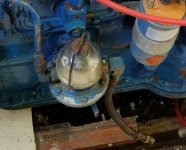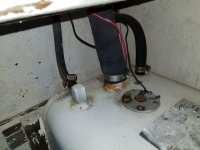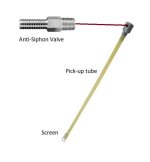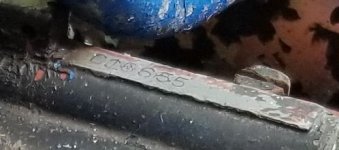jaschrumpf
Contributing Member
I'm looking at a 1961 Dorsett San Juan to buy, and it has the original BB70 engine with AQ100 outdrive (is that the correct nomenclature?) At any rate, it's a BB70 engine with a PV outdrive hanging back there.
Anyway, the current owner had never got the engine started. He was told by the previous owner that it did run, but after moving the boat down from Philly, he realized he'd forgotten the keys, and when the owner mailed them down the keys fell out of the envelope en transit and were lost. He bought a new ignition switch, hadn't been able to get the engine running after hooking it up. Fast forward a year and a half and he and I are trying to start the engine. It would turn over but not catch and try to run.
I looked the wiring over, and it was all messed up: the yellow-red-striped wire that should have gone from the ST post on the key to the S post on the solenoid went to the big terminal instead, and I never did figure out what happened to the wire that was supposed to go from the IGN post on the key to the POS terminal on the coil, as the wire changed color from one end to the other. As a result, there was no voltage at the coil at all, so no spark.
The owner and I pulled out all that wire and ran new wire correctly and in the correct gauge, and I put in new spark plugs, gapped to 0.30. Then I took off the dist. cap and sprayed some WD40 in there to dry it out. The fuel line had been removed from the tank and run into a 1-gallon gas can, and I don't know anything about that fuel pump, so I wasn't surprised that our first attempt did nothing, even after pumping the throttle a couple of times. But when we poured a teaspoon of gas into the carb and turned the key, she roared into life for about two seconds, then ran out of fuel.
We tried it a couple more times to see if it would ever suck fuel out of the gas can, but it didn't. Is there some way to prime that mechanical fuel pump?
Anyway, it was a good start, and I'm looking forward to working on it some more.
Anyway, the current owner had never got the engine started. He was told by the previous owner that it did run, but after moving the boat down from Philly, he realized he'd forgotten the keys, and when the owner mailed them down the keys fell out of the envelope en transit and were lost. He bought a new ignition switch, hadn't been able to get the engine running after hooking it up. Fast forward a year and a half and he and I are trying to start the engine. It would turn over but not catch and try to run.
I looked the wiring over, and it was all messed up: the yellow-red-striped wire that should have gone from the ST post on the key to the S post on the solenoid went to the big terminal instead, and I never did figure out what happened to the wire that was supposed to go from the IGN post on the key to the POS terminal on the coil, as the wire changed color from one end to the other. As a result, there was no voltage at the coil at all, so no spark.
The owner and I pulled out all that wire and ran new wire correctly and in the correct gauge, and I put in new spark plugs, gapped to 0.30. Then I took off the dist. cap and sprayed some WD40 in there to dry it out. The fuel line had been removed from the tank and run into a 1-gallon gas can, and I don't know anything about that fuel pump, so I wasn't surprised that our first attempt did nothing, even after pumping the throttle a couple of times. But when we poured a teaspoon of gas into the carb and turned the key, she roared into life for about two seconds, then ran out of fuel.
We tried it a couple more times to see if it would ever suck fuel out of the gas can, but it didn't. Is there some way to prime that mechanical fuel pump?
Anyway, it was a good start, and I'm looking forward to working on it some more.





